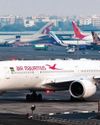Air Deccan 2.0: Smaller And Wiser
Cruising Heights
|February 2018
The pioneer of low cost air travel in the country, Capt G R Gopinath, is on his second innings with Air Deccan 2.0. AJAY AWTANEY, who flew from Mumbai to Nashik recently, finds out how different the new Air Deccan is.

Air Deccan, the original low-cost carrier of India, recently took wings again. Launched in 2003 for the first time, the airline has a totally different operating model in the new launch, but some things remain the same: Captain Gopinath’s ambition to connect India beyond the metros, and the iconic one rupee tickets which unleashed yield management in India.
Air Deccan 1.0
In keeping with the agenda, the first time around, Deccan started flying to airports such as Hubli on ATR 42 aircraft, an agenda which quickly got sidetracked in competing with the full-service carriers on trunk routes. Deccan quickly leased a couple of Airbus A320 aircraft and ordered 30 jets, along with 30 ATRs to keep connecting India.
On the trunk routes, the airline offered a fare that was usually about 30 percent lesser than full-service carriers, quickly gaining market share to become the third-biggest carrier in India in 2006. Deccan ensured it spread fast, operating 69 stations within the first five years.
One of the biggest contributions Deccan made to Indian aviation was yield management and a true low-cost airline. Being the first LCC, it priced tickets across the spectrum with cheaper prices if you booked long before the day of travel and more expensive pricing as you booked closer to the travel date.
Esta historia es de la edición February 2018 de Cruising Heights.
Suscríbete a Magzter GOLD para acceder a miles de historias premium seleccionadas y a más de 9000 revistas y periódicos.
¿Ya eres suscriptor? Iniciar sesión
MÁS HISTORIAS DE Cruising Heights

Cruising Heights
Training India's Business Jet Pilots
India's expanding business aviation market faces a critical challenge in training and retaining skilled jet pilots, with no local simulators forcing reliance on global networks amid regulatory hurdles and CBTA adoption.
4 mins
December 2025

Cruising Heights
THE YEAR OF VISIBLE CHANGE FOR AIR INDIA
Something unusual is happening at Air India, the kind of shift that aviation insiders feel before the public even sees it.
9 mins
December 2025

Cruising Heights
REGIONAL CONTENDER
China's COMAC is targeting exports of its C919 and C909 civil jetliners
8 mins
December 2025

Cruising Heights
PROPULSIVE POSSIBILITIES
This year's Dubai airshow provided an insight into next-generation propulsion technologies for civil aviation.
11 mins
December 2025

Cruising Heights
TWIN ENGINES OF GROWTH HOW NMIA AND NIA WILL REWRITE INDIA'S AIR CARGO STORY
India is on the cusp of an air-cargo transformation unlike anything seen since the post-liberalisation boom.
7 mins
December 2025

Cruising Heights
CSMIA SETS NEW OPERATIONAL RECORD IN SINGLE DAY ATMS
On November 21, 2025, Mumbai's Chhatrapati Shivaji Maharaj International Airport (CSMIA) achieved a remarkable operational milestone amid the festive season's travel boom, recording 1,036 Air Traffic Movements (ATMs) in a single 24-hour period (from 00:00 IST).
1 min
December 2025

Cruising Heights
A NEW CHAPTER IN AMPHIBIOUS AVIATION
The future of amphibious aviation is being shaped in unexpected places, and few stories illustrate this better than Jekta's.
5 mins
December 2025
Cruising Heights
AN A320 GLITCH AND A SOFTWARE UPDATE
A software flaw in Airbus A320-family jets has forced urgent fixes and grounded aircraft across Indian airlines, causing mounting delays and nationwide schedule disruption as this panorama tracks the scale, impact, and evolving response to the crisis.
1 mins
December 2025

Cruising Heights
CARGO REBOUNDS: INDIA'S TERMINALS LEAD THE CHARGE
India's air cargo sector crossed a clear inflection point in FY2024-25, with volumes rising by about ten per cent, with major metro hubs reshaping logistics footprints, corporate strategies and airport investments.
7 mins
December 2025

Cruising Heights
Safety lessons in general aviation
As India's general aviation sector anticipates rapid growth, safety concerns intensify. Regulators must leverage these incidents to build a robust safety ecosystem with stringent checks and swift corrections.
8 mins
December 2025
Translate
Change font size

